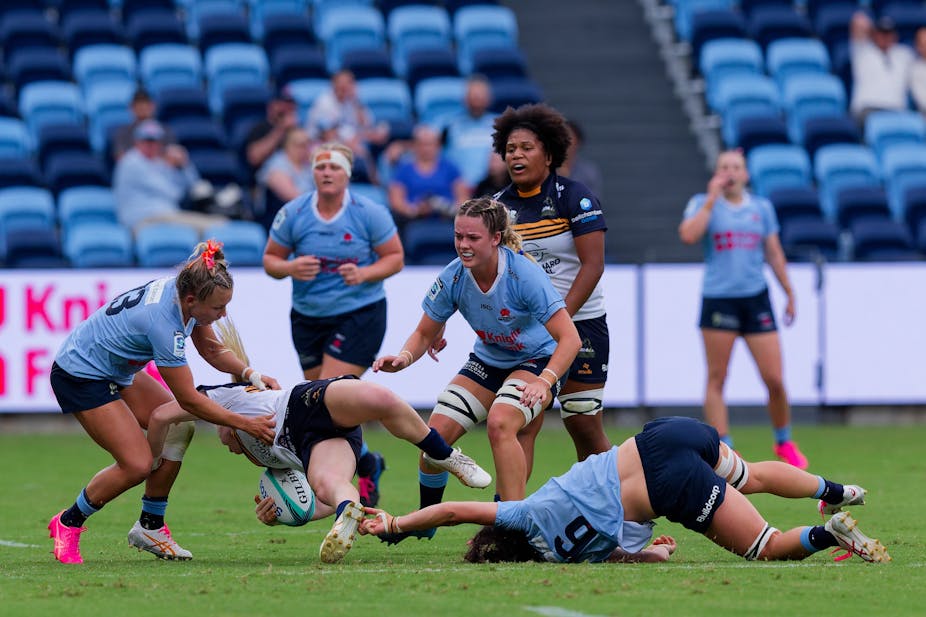As the Women’s Six Nations continues, drawing in bigger crowds and more media attention than ever before, it feels like a moment to celebrate.
However, it’s important to reflect on the costs of this apparent progress, including the increased risk of brain injury associated with participating in high-impact sports such as rugby.
For Siobhan Cattigan’s family, this cost is all too real. They had to watch their daughter “crumble before their eyes” as her mental health deteriorated it is claimed following brain injuries sustained in rugby training and competition. She died aged 26.
Scientific concerns around sport-acquired brain injuries date back almost a century. The main lesson from this research is that participation in sports that involve regular blows to the body aren’t good for people’s brains.
Until recently, attention was mostly on short-term issues of sport-acquired brain injuries, including impaired cognitive function and mental health problems. Consequences for mental health are of particular concern given the number of sportspeople dying from suicide attributed by their families to brain injury.
However, it’s the long-term issue of the risk of loss of brain function that has propelled this problem into the mainstream. Chronic traumatic encephalopathy (CTE) has been the driving concern here. CTE is a degenerative brain disease probably caused by repeated blows to the brain. There’s no cure, and the disease can only be diagnosed after death.
Living with the disease is brutal, and families and friends have to witness their loved ones become unrecognisable.
CTE has been diagnosed in deceased professional and amateur athletes, as well as in the brains of athletes under the age of 30. In 2023, researchers at the Australian Sports Brain Bank reported the world’s first diagnosis of CTE in a sportswoman.
Progress for women, but at what costs?
Given this context, our recent paper, written with colleagues at Nottingham Trent University, has asked difficult questions about the consequences of the much-celebrated rise in women’s participation in rugby and other impact sports.
Women have long fought for access and representation in sport. Important progress has been made, with sportswomen gaining more media attention, greater opportunities to make a living from sport, and increased access to play male-dominated sports.
But in sports where the rules of play make brain injury an anticipated consequence– such as the tackle in rugby – we should be wary of celebrating women’s “progress” in increased participation.
And despite progress, sportswomen still face inequalities in accessing resources and medical care that may place them at a higher risk of the consequences of brain injuries.
Most people play sport because it’s fun and can be a good way to be active. But sport is continuing to be narrowly defined around performance. What was once folk games and loosely organised pastimes is now a highly organised institution in which, from very young ages, children and young people are brought into a world largely built on trying to win often at the sacrifice of health.
As women’s rugby transitions toward professionalism, including the recent announcement of the first US women’s rugby union professional league that will launch in 2025, we should expect to continue seeing an increase in women and girls suffering because of sport-acquired brain injuries- like we have seen in the men’s game for some time.
For professional sport to be sustained, it relies on a high level of grassroots participation to identify the next generations of elite sportspeople. Consequently, many sporting organisations target children and young people’s leisure time as an opportunity to recruit “talent”.
With the professionalisation of women’s rugby, we can expect to increasingly see recruitment among young girls. World Rugby recently reported that one of its three core growth areas is to increase women and girls’ participation and England Rugby has just announced a £12 million investment in the women’s grassroots game.
Alongside this, there are now over 450 current and former rugby players who have joined lawsuits to take legal action against World Rugby and the national governing bodies of England and Wales for negligence and failure to protect them from brain injuries. And despite academic evidence and medical consensus, rugby organising bodies are yet to recognise a formal link between their sport and increased risk for CTE.
These facts make it difficult to have confidence in rugby organisations prioritising children’s safety.
Read more: Children's high-impact sports can be abuse -- experts explain why
Consenting adults should be allowed to enjoy risky sports like rugby. And women should not be viewed as the fairer sex who need special protection from sport-acquired brain injuries.
But the established science on the known and real harms associated with sports like rugby should force people to reflect on the costs of uncritically striving for gender equality in participation in these sports.
So, as people watch and cheer the highly skilled women competing in the Six Nations, let us not forget the brains being damaged for entertainment.

